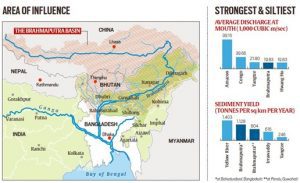Ahmedabad
(Head Office)Address : 506, 3rd EYE THREE (III), Opp. Induben Khakhrawala, Girish Cold Drink Cross Road, CG Road, Navrangpura, Ahmedabad, 380009.
Mobile : 8469231587 / 9586028957
Telephone : 079-40098991
E-mail: dics.upsc@gmail.com

Assam Floods
News: Torrential Rainfall and landslides in the past few days have eroded sections of roads and railway tracks in Assam. The weather department has predicted that ‘extremely heavy rains’ will continue for the coming days as the states stay on ‘red alert’.
Why are floods common in Assam?
High percentage of Flood prone region
• 31.05 lakh hectares of the total 78.523 lakh hectares of the area of the state is prone to frequent floods. Both man-made and natural factors are reason behind this high flood prone area.
River Brahmaputra
• The river is braided and unstable in its entire reach in Assam except for a few places. The main reason behind the instability of river are high sedimentation and steep slopes.
Earthquakes/Landslides
• Assam lies in the seismic zone Assam and some other parts of the northeastern region are prone to frequent earthquakes, which causes landslides. The landslides and earthquakes send in a lot of debris in the rivers, causing the river bed to rise.
Dams
• One of the man-made reason for key cause of floods in Assam region is releasing of water from dams situated uphill. Unregulated release of water, floods the Assam plains.
Encroachment
• Population density of Brahmaputra river valley was 9-29 people per sq.km in 1940-41. However, this shot up to 200 people per sq.km now according to Brahmaputra board.
• Unplanned expansion of the urban areas has led to severe encroachments in the wetlands, low lying areas, hills and shrinkage of forest cover.
Bank Erosion
• Assam has also faced bank erosion around the Brahmaputra and Barak rivers as well as their tributaries.
• It is estimated that annually nearly 8000 hectares land is lost to erosion. Bank erosion has also affected the width of the Brahmaputra river, which has increased up to 15 km.
How has government tried to intervene? Why have they failed?
• Floods are recurrent feature during monsoons in Assam. In fact, the ecologists have argued that the annual phenomenon play an important role in maintaining the balance of local ecosystem.
• The floodwaters deposit nutrients that make the grassland more fertile. This means more food for Rhinos and other herbivores. Floods also help root out invasive species like water hyacinth, which threatens the native flora that rhinos eat.
• But it’s also a fact that for more than 60 years, the centre and state governments have not found ways to contain the toll taken by the raging waters.
• The state has primarily relied on embankments to control floods. This flood control measure was introduced in Assam in the early 1950s when the hydrology of most Indian rivers, including the Brahmaputra, was poorly understood.
• But, several of the state’s embankments were reportedly breached by the floods this year.
• Experts blame the piece-meal approach behind flooding. Lot of agencies work on it but there is no coordination among them.
What is the way forward?
• Involving local communities in the processes of flood governance, who often possess rich local knowledge about adaptation to and governance of flooding.
• Rejuvenating of wetlands before monsoon can help in mitigating flood in parts of state.
• Studying the river and the impact of climate change is a must to understand why the state gets flooded every year.
• Water flow information shared by China on the Brahmaputra with India, for which India pays a certain amount, should also be shared with the public, as this will help in understanding the river better and therefore help people better prepare for floods.
• More accurate and decentralised forecasts of rain can help in improving preparedness. Weather reports should be made available on district level and should be accessible to public.

Address : 506, 3rd EYE THREE (III), Opp. Induben Khakhrawala, Girish Cold Drink Cross Road, CG Road, Navrangpura, Ahmedabad, 380009.
Mobile : 8469231587 / 9586028957
Telephone : 079-40098991
E-mail: dics.upsc@gmail.com
Address: A-306, The Landmark, Urjanagar-1, Opp. Spicy Street, Kudasan – Por Road, Kudasan, Gandhinagar – 382421
Mobile : 9723832444 / 9723932444
E-mail: dics.gnagar@gmail.com
Address: 2nd Floor, 9 Shivali Society, L&T Circle, opp. Ratri Bazar, Karelibaugh, Vadodara, 390018
Mobile : 9725692037 / 9725692054
E-mail: dics.vadodara@gmail.com
Address: 403, Raj Victoria, Opp. Pal Walkway, Near Galaxy Circle, Pal, Surat-394510
Mobile : 8401031583 / 8401031587
E-mail: dics.surat@gmail.com
Address: 303,305 K 158 Complex Above Magson, Sindhubhavan Road Ahmedabad-380059
Mobile : 9974751177 / 8469231587
E-mail: dicssbr@gmail.com
Address: 57/17, 2nd Floor, Old Rajinder Nagar Market, Bada Bazaar Marg, Delhi-60
Mobile : 9104830862 / 9104830865
E-mail: dics.newdelhi@gmail.com